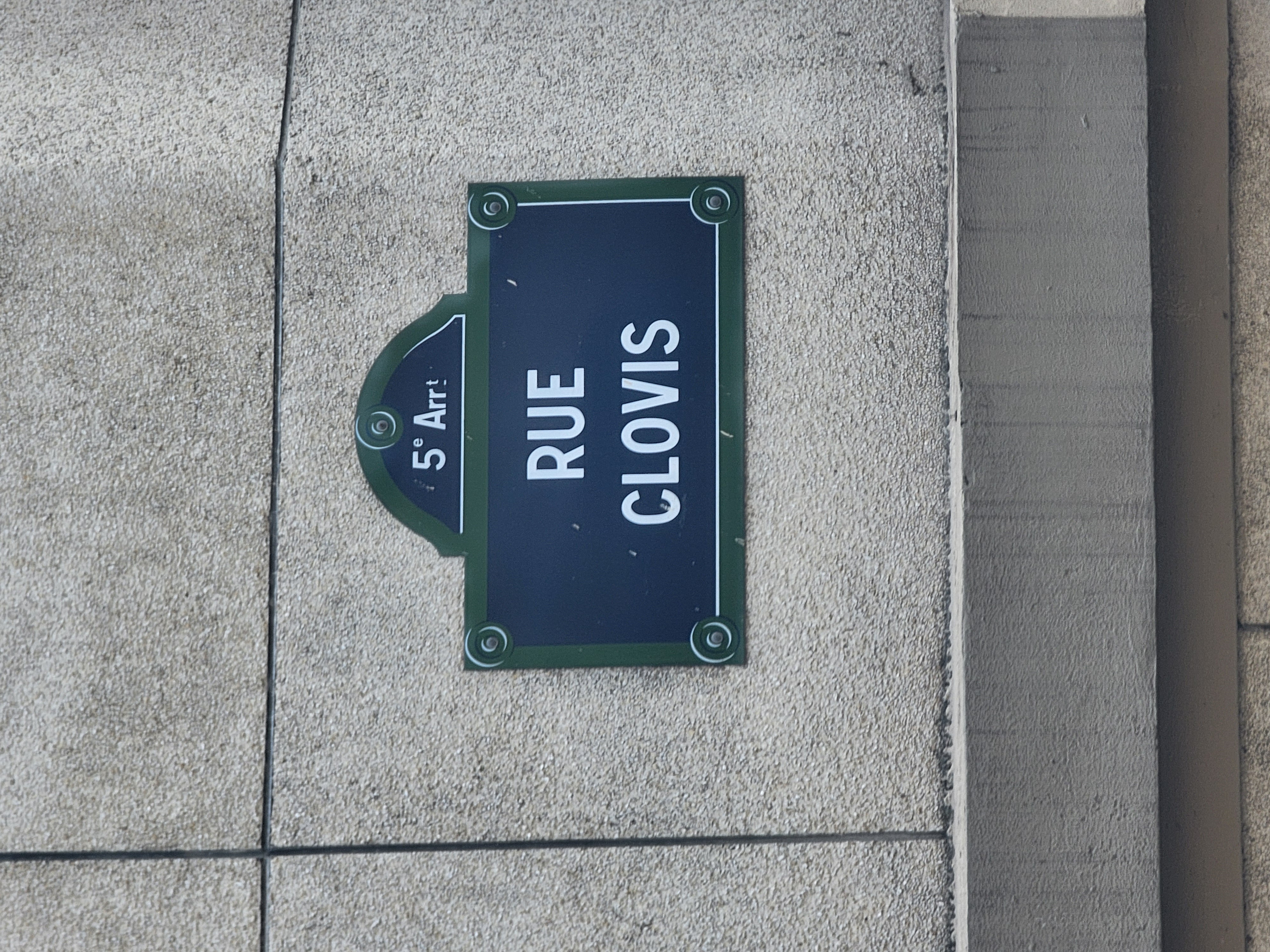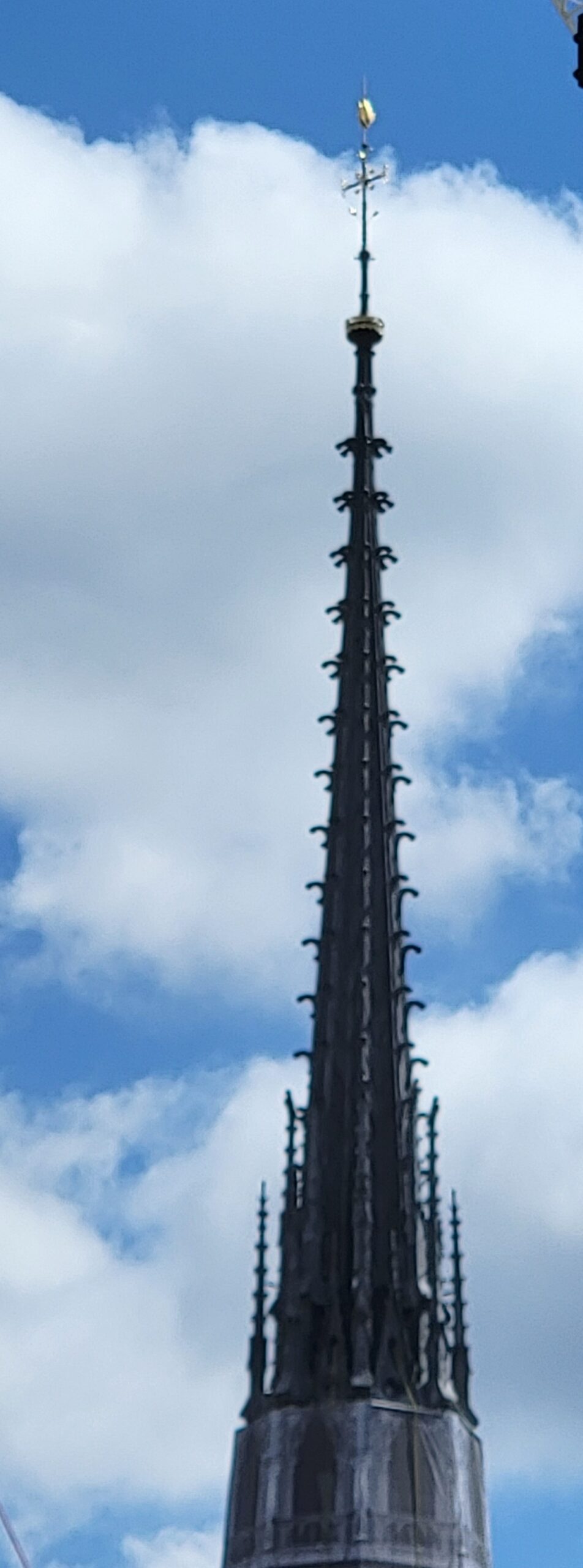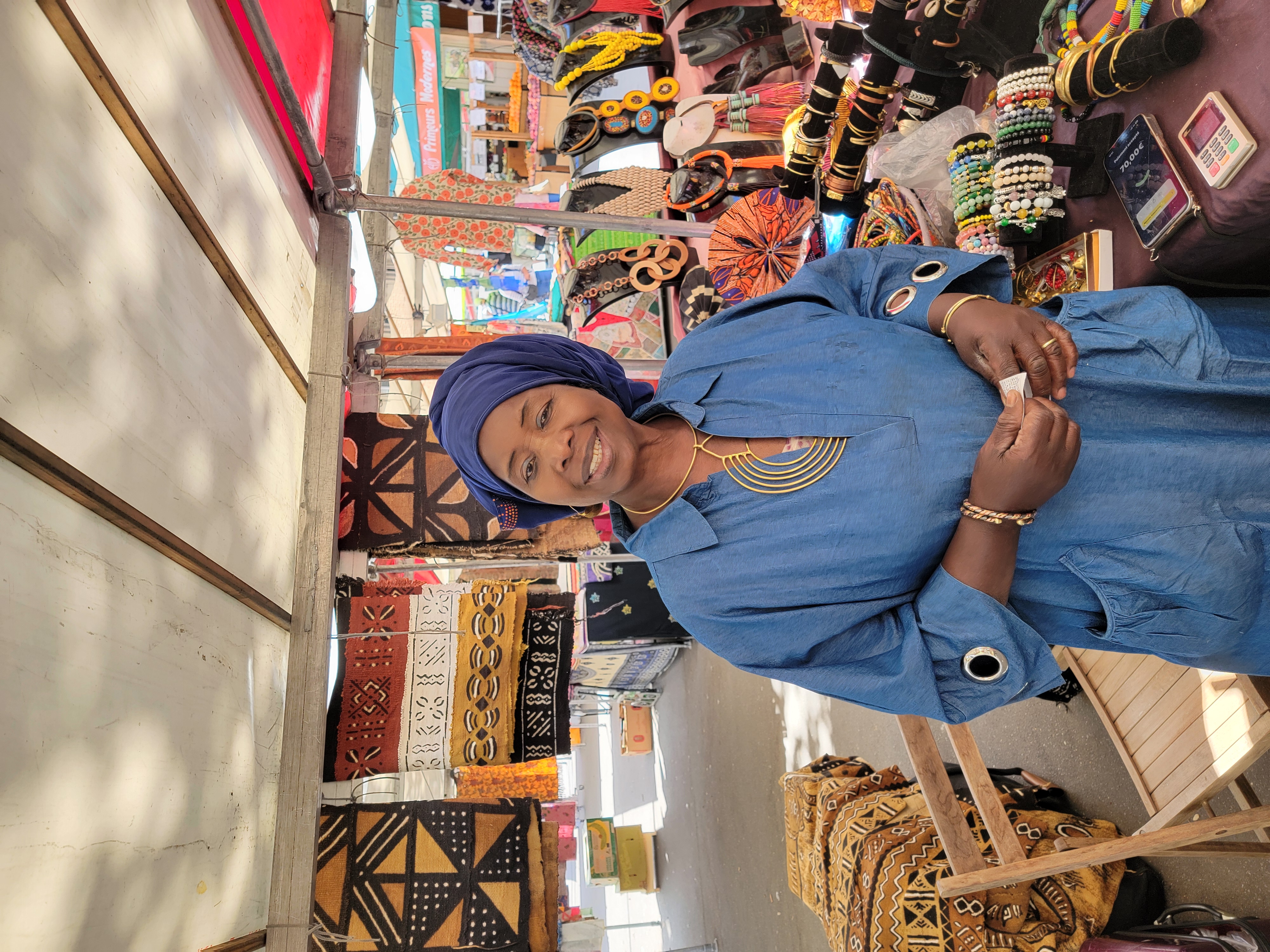Yes, as I (finally) type this, it’s a few days after I returned to California. My luggage, unfortunately, did not. The learning: If you’re taking all your underwear on a trip, be sure to bring some back in your carry-on….
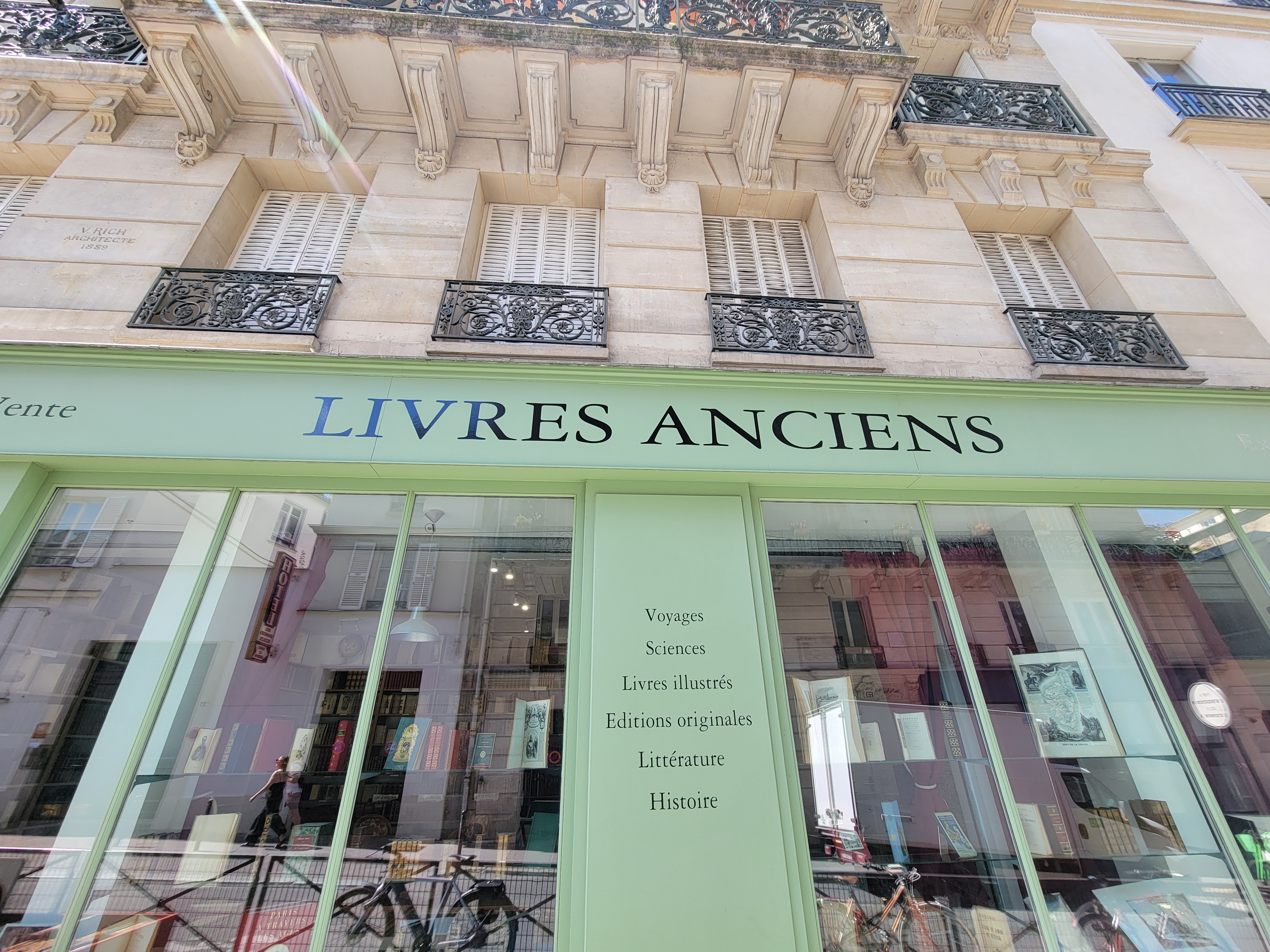
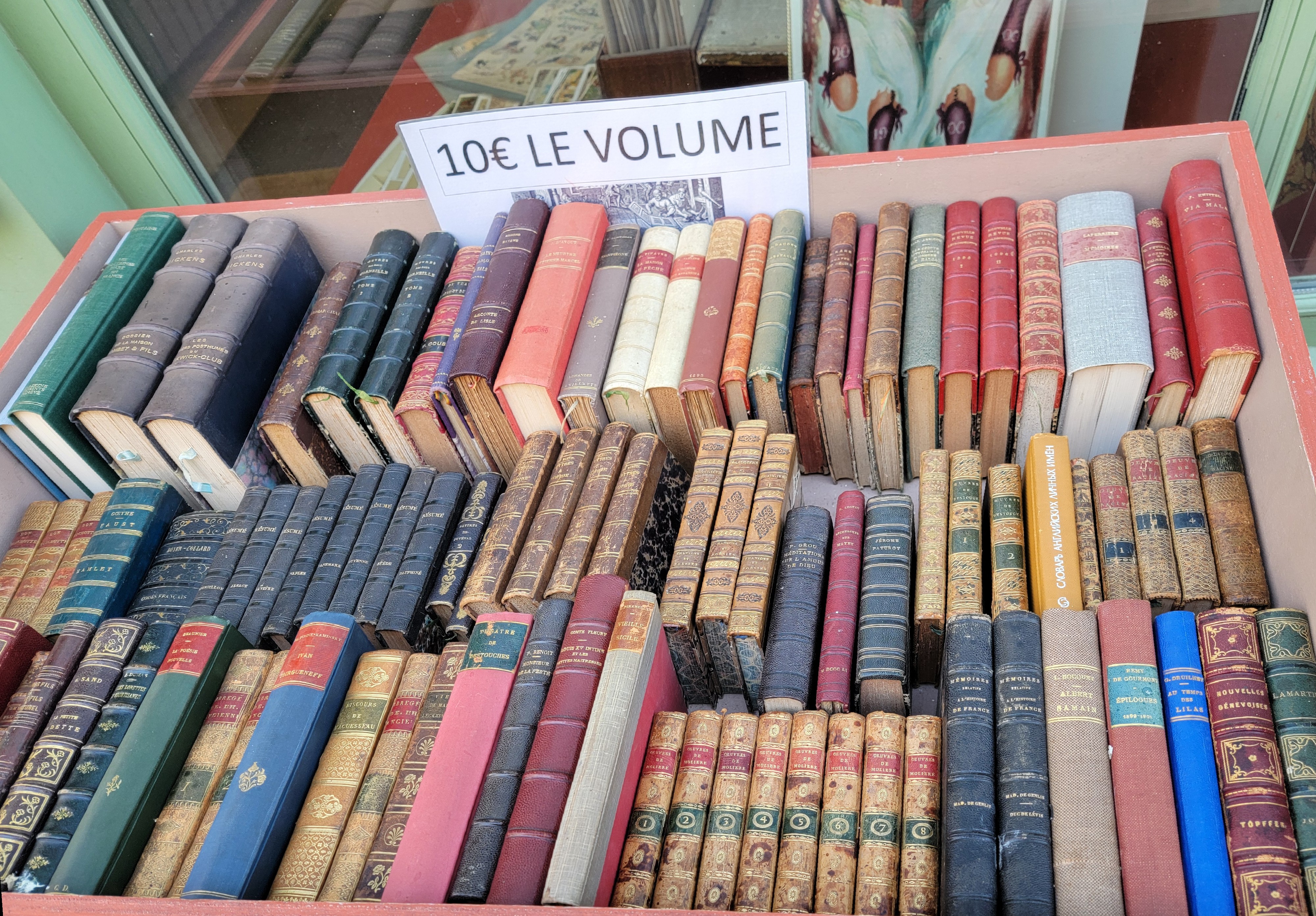
Now, for Day 15. We did another tour with the Earful Tower folks, and in fact had Hannah again as our tour guide.
Unfortunately ( :-( ) TripIt (which is great, by the way) had “overwritten” the address to meet in the Latin Quarter with the address for the Peloton Cafe (Marais Tour).
Funny how your mind works…
As we were on the Metro to our (incorrect) destination, I mentally moved the Latin Quarter to the other side of the Seine (since that’s where we were going), etc. The plus side was that Oliver – “Mr. Earful Tower” – and his son were having a coffee outside Peloton Cafe, so we got to actually say Hi in person, before jetting off to where we were SUPPOSED to be (sigh).

Luckily, we were having a tour with the Aments, not “strangers,” so though it did lead to some good-natured ribbing, we were only about 15 minutes late. (So much for that breakfast we had “left time for” LOL).
Hannah once actually lived in the Latin Quarter, on Rue de Irelandais (“Street of the Irish”). They have accommodations for Irish students that she took advantage of. In walking past her former digs, we learned that the “Latin Quarter” is so named because it is the center of scholarship and study. The Sorbonne is here, and originally students/scholars spoke Latin. (So much for the idea that it was an area of salsa and tango!)
While Montmartre is known to be the area for those carrying out artistic pursuits (dancers, artists), The Latin Quarter was known for those with “intellectual pursuits,” such as scholars, writers, and the like. It is the area with the most book shops in Paris.

One of our first stops was at a “James Joyce lived here” plaque. Hannah opined that of course Joyce is Irish – but when they put up the plaque, he was a “British writer, of Irish origins.”
Mr. Joyce, to put it nicely, “lived on others’ generosity.” He had no problem running up bills, then sending them on for others to pay. When the “others” decided that they were tired of paying for the Ritz, he had to move here, which was definitely a step down – at that time, it was the “writers’ Montmartre” – not known for being swanky digs.
As we strolled past Rue de Clovis, Hannah mentioned that he was a famous French king from the 6th Century. (I actually remember this – I had to memorize all the kings of France in some French class or another – the only one I remember is Clovis because my mnemonic had him with “Cloven” hooves.) Interestingly, a while after Clovis, “Louis” became a kingly name. But it doesn’t have any real origin. The thought is that it was actually bastardized *from* “Clovis” – that the “C” was lost, and then the “V” became a “U” et voila – “Louis.”
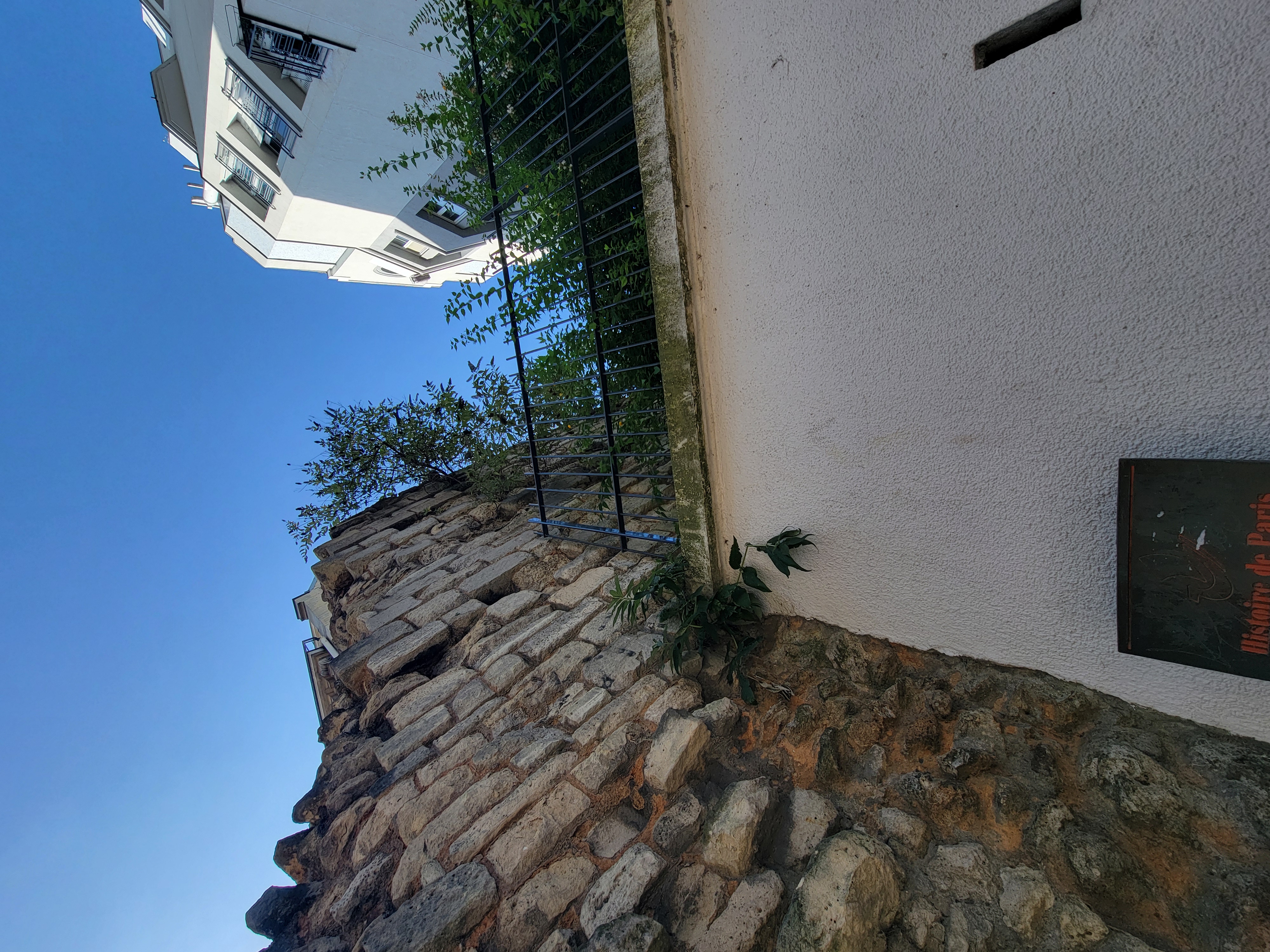

We found another chunk of The Wall that Oliver is so passionate about. I talked a bit about this in the Marais tour writeup. As a reminder, it was built by Philip II Augustus (who ruled from 1165-1223) in 1190, to make Paris a “fortress” when he went off reluctantly to take part in the Crusades. It was 16 miles in circumference. As you may remember, Louis XIV tore it down, because he considered himself a very successful king, and felt that his “name” would protect Paris and that having a wall made him look bad.
All over Paris, the city had grown “around” the wall, however, so tearing it down wasn’t quite that easy. There are still sections, now almost 1,000 years later, in people’s basements, underground parking lots – the big stretch we saw in the Marais – and smaller pieces here and there. Hannah said that an office building even has a piece of a tower in it. What we came to here was a piece of the wall that some apartments had been built into. It went on 15 feet more inside the area where we were standing. Hannah told a story of a woman from this apartment who barely avoided being knocked out by one of the stones falling out of the mortar; when she called the city about it, they came and gingerly took the stone away – because it’s not just a potentially head-bashing stone – it’s “historical”! :-)




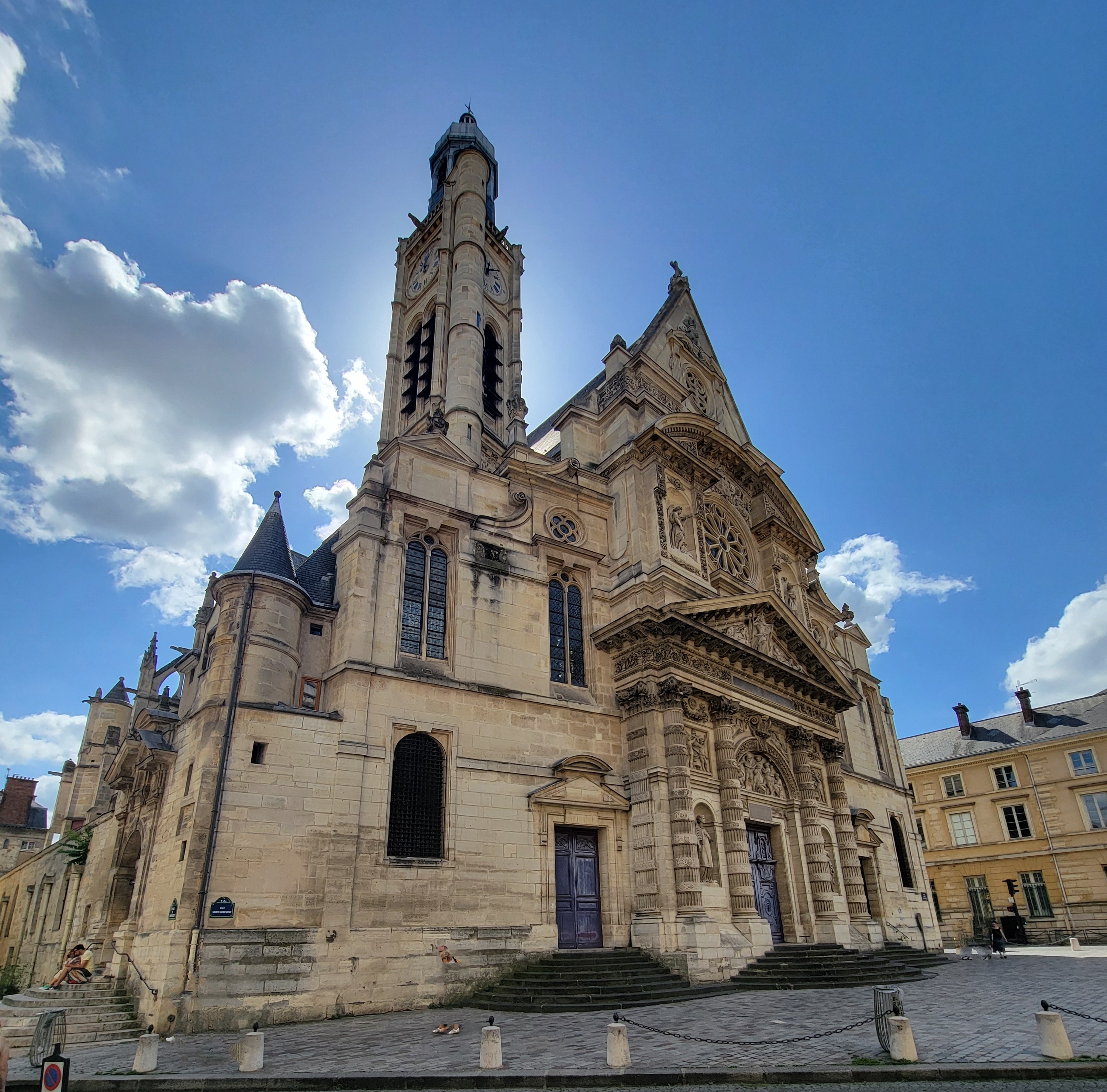


Next we walked past the Lycee Henry IV (I think). It is a very famous high school, where Emmanuel Macron, Sartre, and a number of others attended. It was built on the grounds of the Abbey of St. Genevieve, which was built in the 6th or 7th century. In the photo with the girl wearing red shorts, the stairs that you can barely see to the left side with a couple sitting on them were in the movie Midnight in Paris, when the car comes to pick up Owen Wilson. (I really really liked that movie. I’m going to have to rent it again.)
We headed to Rue Descartes (though I don’t have a photo): Descartes was enormously prolific during his lifetime, and is basically now only known for one phrase, “I think, therefore I am.”
This sign at left, at Maison Verlane, says Hemingway lived in the building, but that’s just half true.
Hemingway moved here with his first of four wives and their child, as a journalist for Canada.
(Leann picked up a book at the airport, “The Paris Wife,” a novel about that wife, Hadley Richardson.)
The apartment that they lived in was pretty rustic, so Hemingway took a studio at Maison Verlane, so he could write there.
Below are some pictures of Amorino ice cream on Place de la Contrescarpe: They build a flower out of the three flavors you choose for your cone.
Place de la Contrescarpe takes its name from the area around the former street rue de la Contrescarpe-St.-Marcel. “Contrescarpe” (same word in English without the final E) means an embankment outside a ditch or moat. This one was the embankment outside The Wall.
There are two cafes across from one another on both sides of the park at Place de la Contrescarpe.
One is constantly sunny – that was Cafe des Arts where Hemingway used to hang out. Hannah commented that he was from Florida, so “Small wonder.”
The other is constantly shady – and it’s where Hannah, being Irish-skinned, used to hang out when she lived here!
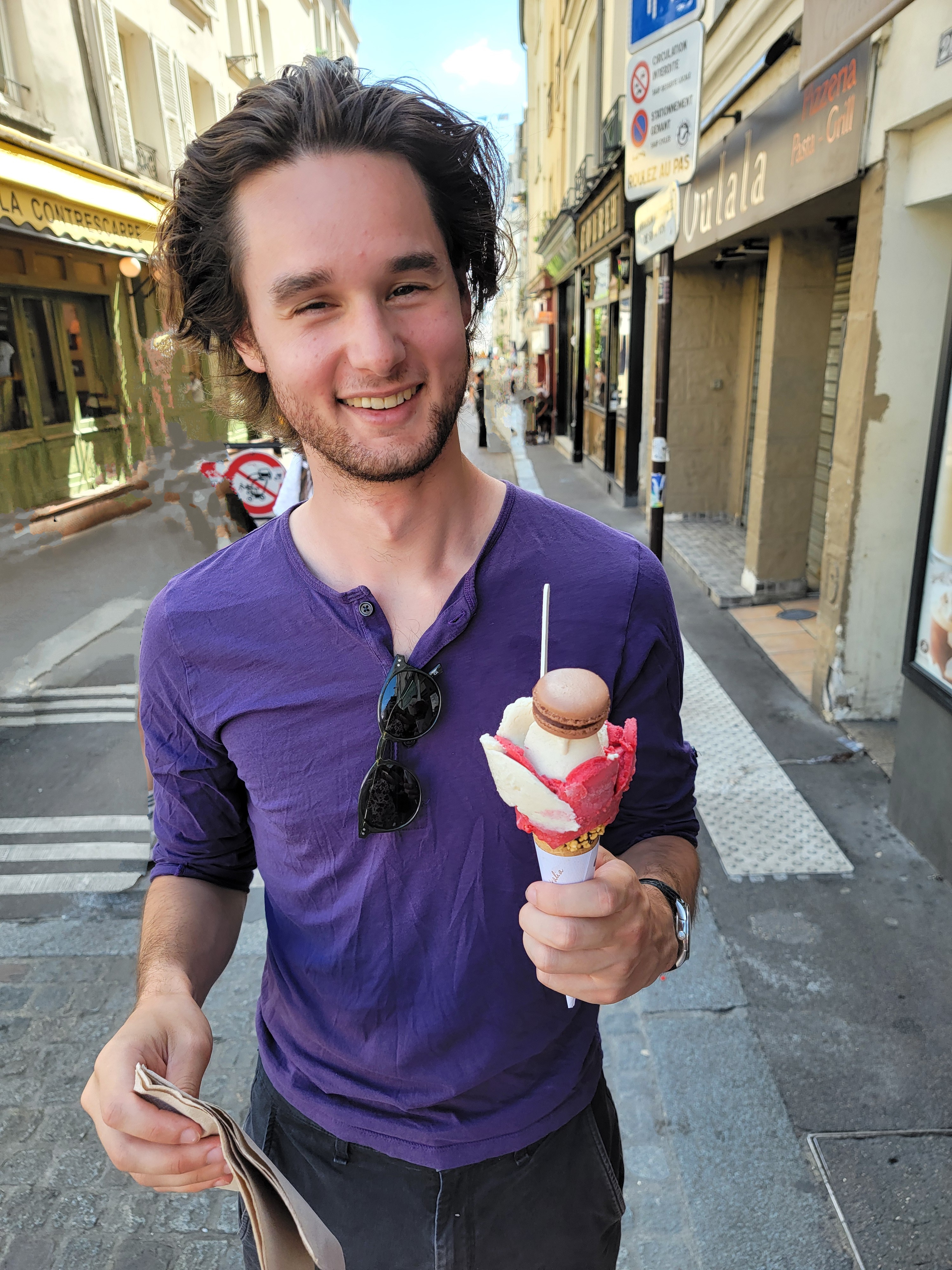


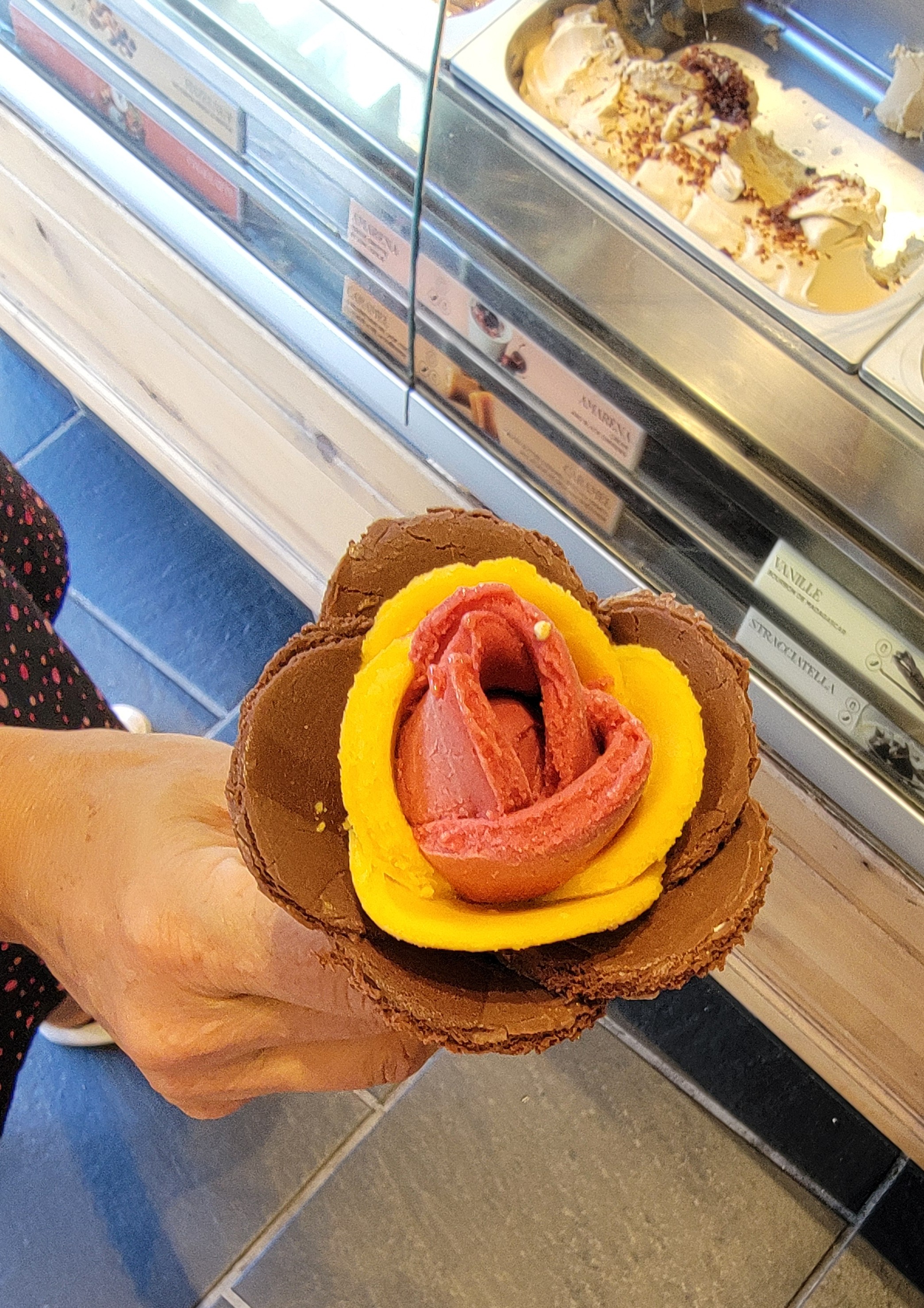
If you were coming from Rome, you would come up Rue Mouffetard to the gate that used to be right here.
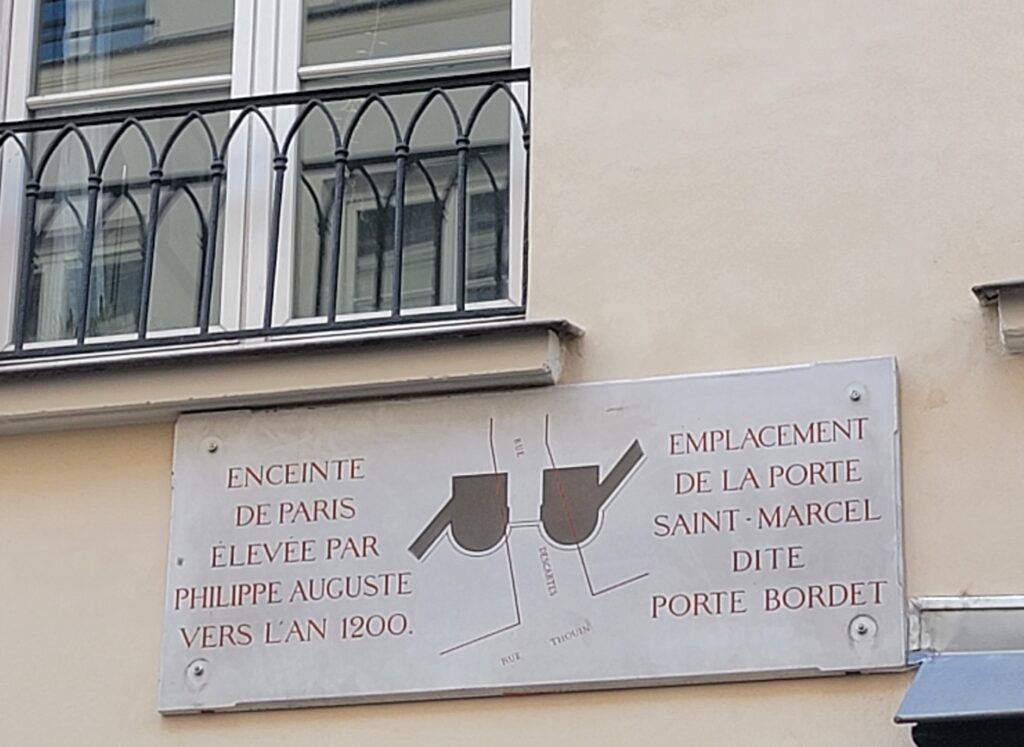
While the name of the street was spelled differently over the centuries, basically it means “stench.” So this was a “stinky street.” Now, it is a very fashionable area to live, with restaurants and bistros, and then as you head along it, it transforms into “Bio” (organic) grocery stores with excellent produce, chocolate shops, etc.

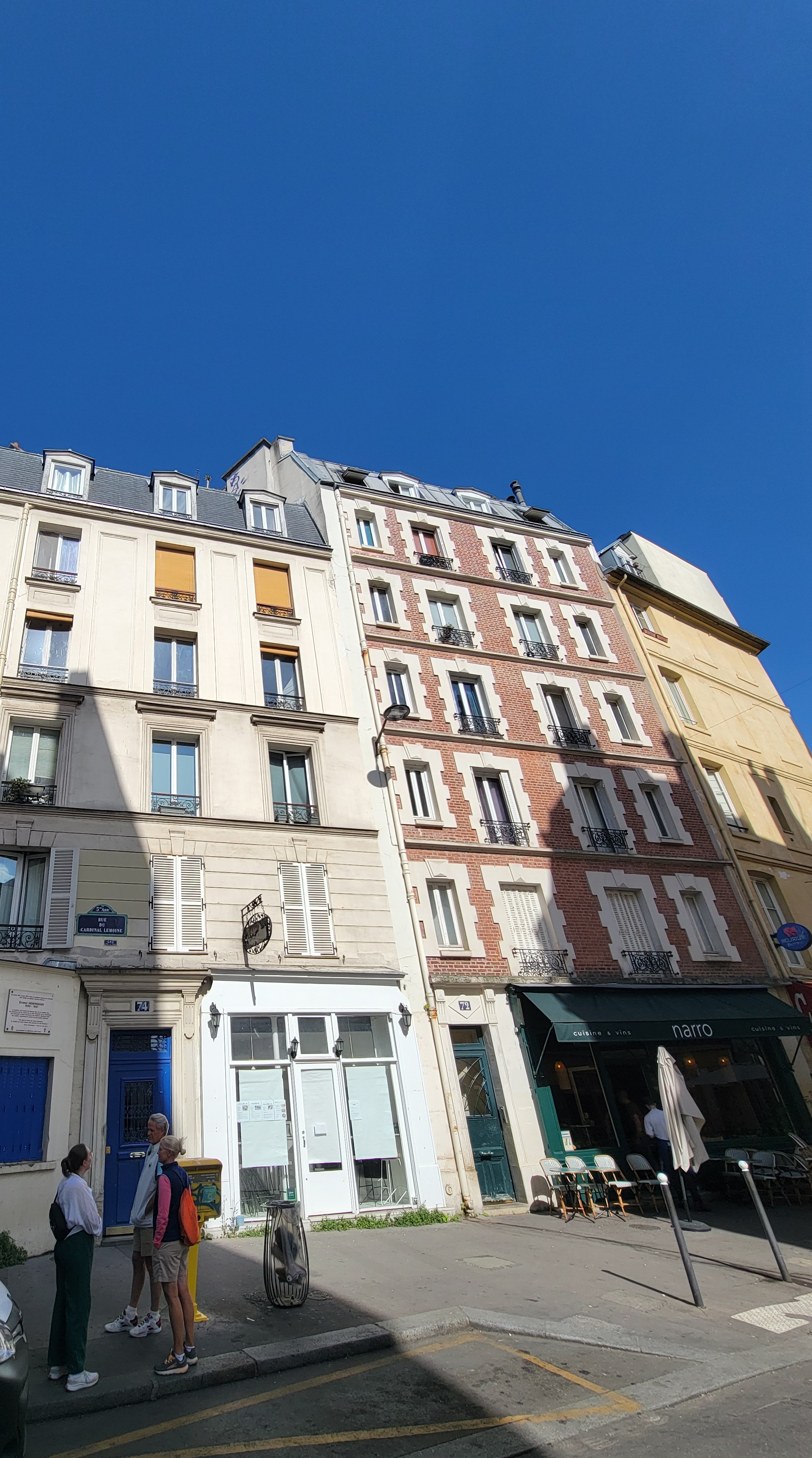

Above is where the Hemingway family actually lived from 1922-23, 74 Rue de Cardinal Lemoine on the third floor. He wrote about this apartment in “The Moveable Feast,” basically stating that it was “before things got sad and seedy,” when he and Hadley were “young, happy and poor.”

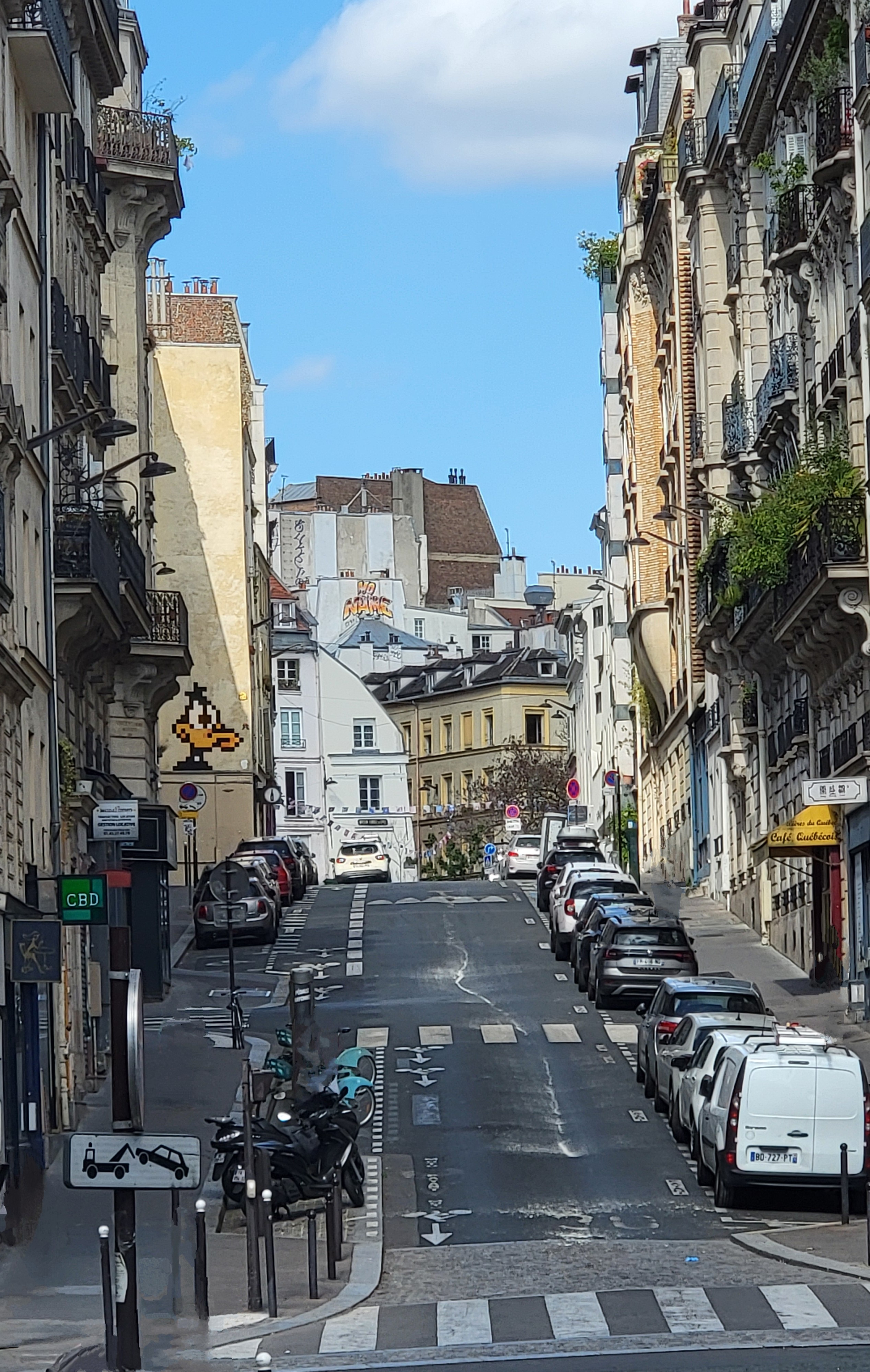
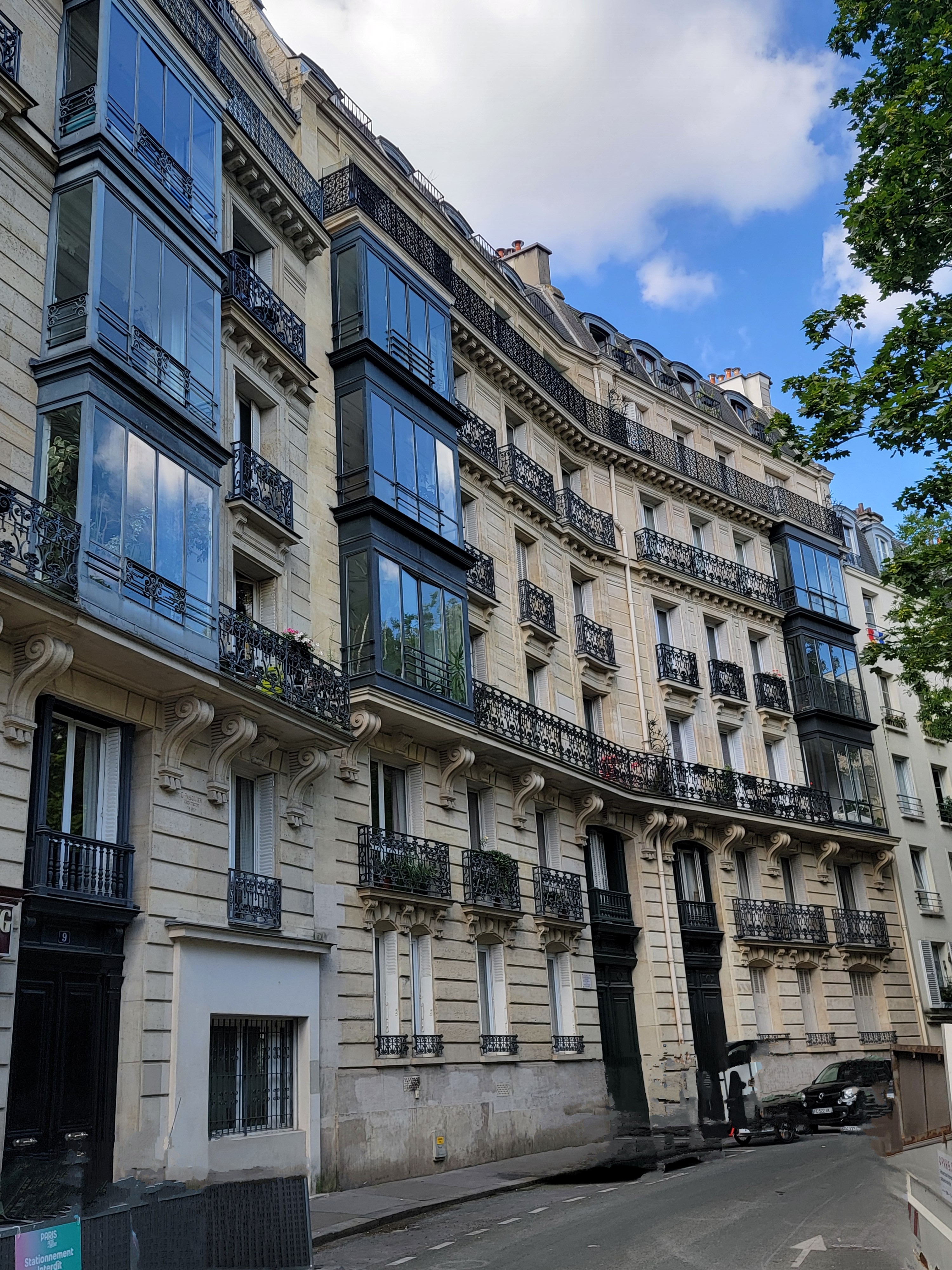

Hannah mentioned that 47,000 buildings were torn down when Haussmann was doing the renovation of Paris. Buildings were taxed based on their footage on the ground – so you will see buildings shaped like “Vs” and with towers that jut out from the side. In the bottom right photo above, these were probably added-on indoor plumbing.




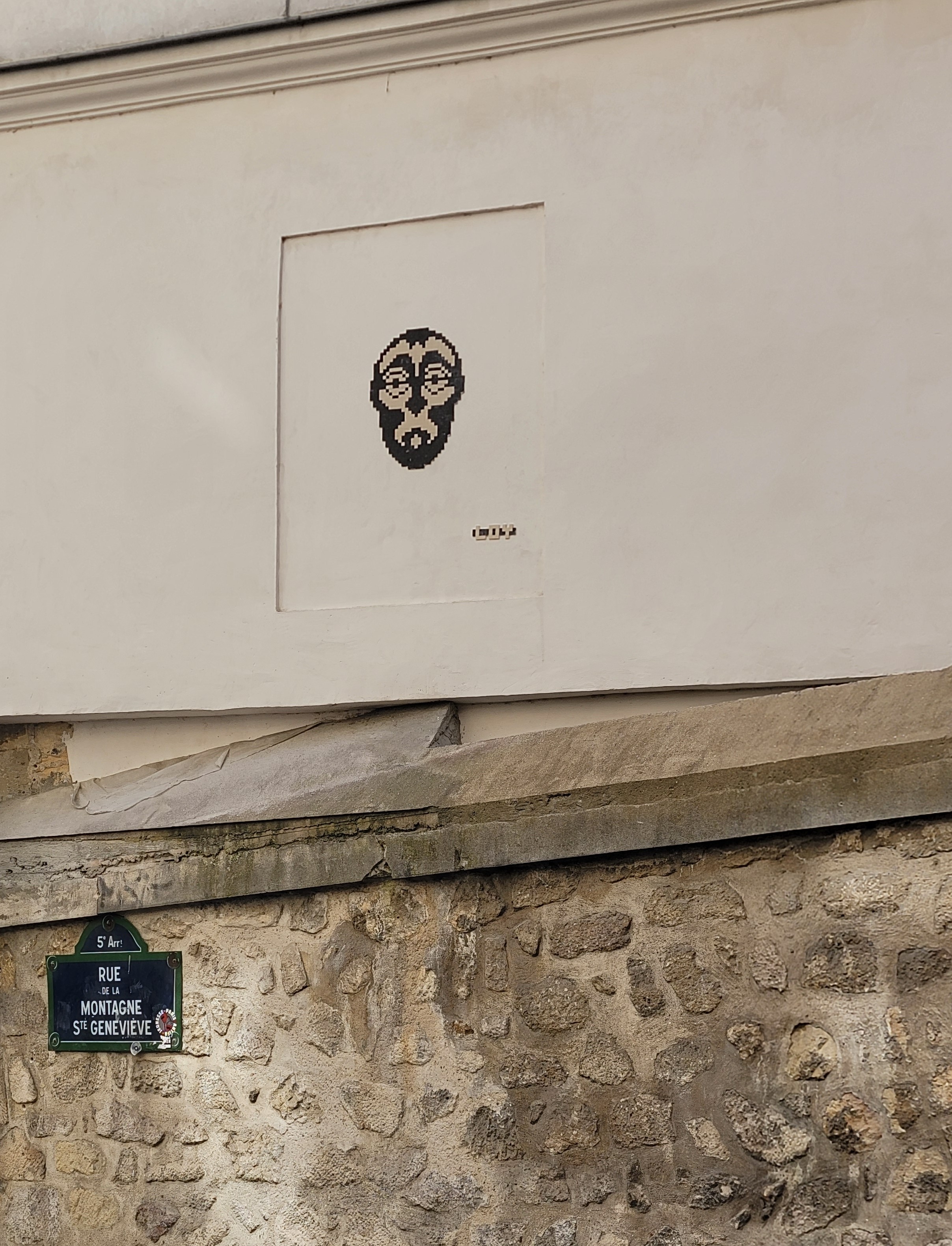



Look at the walls, above. All over Paris (and actually all over the world) you can see these “space invaders.” (There is a “Daffy Duck” in the last set of photos, too.) I can’t remember if I talked about it when writing up the Montmartre tour, but our guide there told us a bit about the artist Invader. He is France’s Banksy. There is even one of his tiles on the International Space Station. From the beginning, he had an app to “log” the art that you found around Paris – and now, internationally. If you are the first to find one of the pieces, you get extra points. The app also tells you whether the art you have photographed is a fake, as there are now a number of imitators!
Invader started about 16 years ago, right around when phones could take photos, and to this day his work shows up out of nowhere. Originally, he did not get permits to do this, but once the French authorities realized that it was a good tourist attractant, they gave him a “blanket permit” to put them up. (The fakes, however, are taken down if they are discovered not to be real.)
His art is attached to popular culture – he often pixilates a well-known picture (ah, copyright infringement LOL). Above you can see a pixelated version of a photo of Nina Simone, and of course Daffy Duck. He does sell artworks (again, a bit like Banksy) that go for millions.
He is very famous for his anonymity – though our guide in Montmartre actually saw him putting up a new one, and was cautioned not to “tell anyone” until it was found on the app. (He said that he didn’t – he was in high school and so awed to see “Invader” that he kept mum.) Invader has an Instagram account, and he gives clues there for new ones. HERE are the ones that cropped up during the Games.


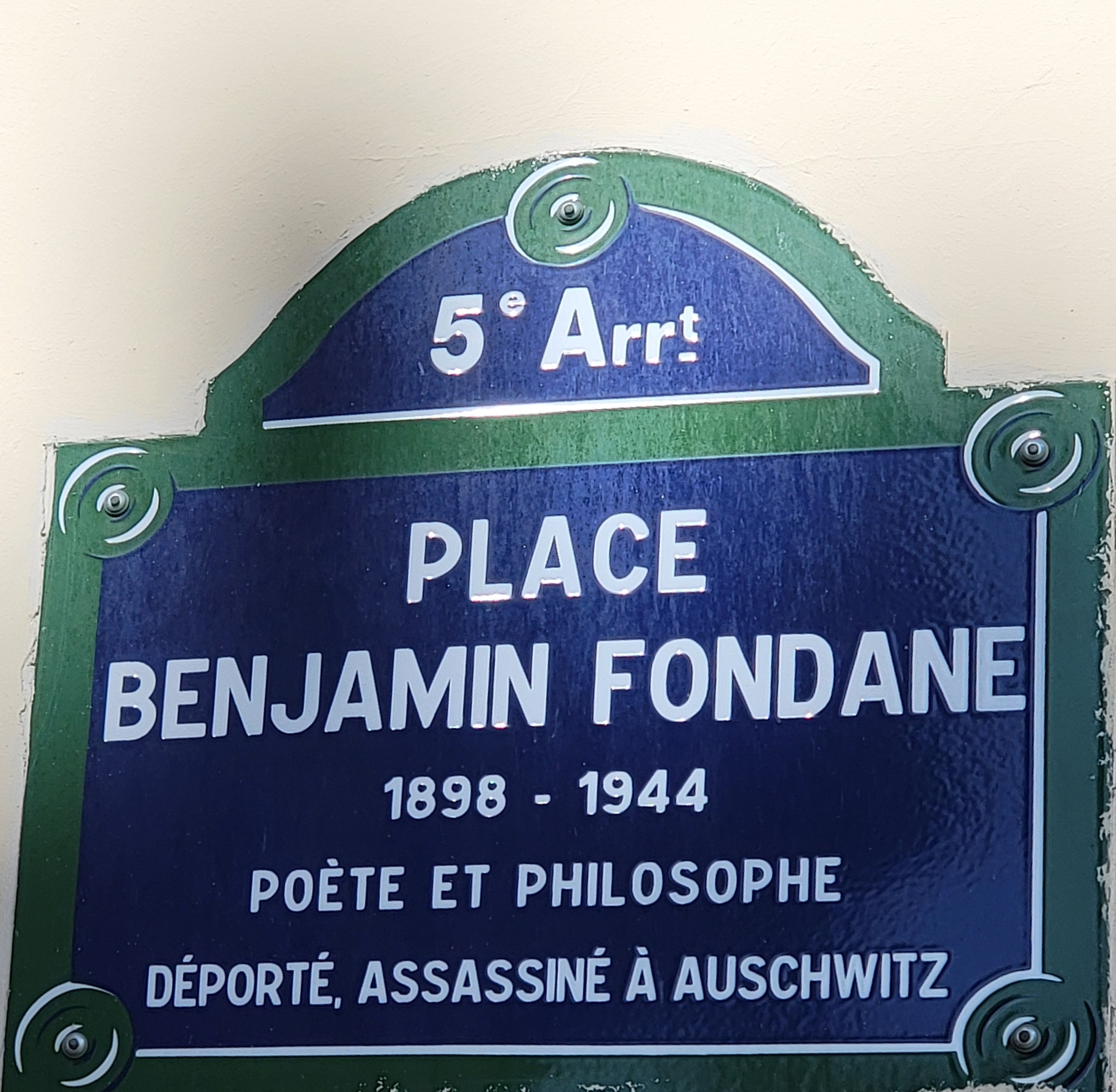
There were a number of commemoration plaques dealing with the Nazis basically clearing out and killing the intellectuals during WW2. We also saw the plaza where the deed was done to some (below).
These stairs are a vertical garden. It was only tiles two years ago.
The neighborhood decided to put the plants in, and Hannah says that she loves coming by to see how it has grown out.
We next visited the Roman Amphitheatre of Lutece (or, the remains of it). It was built in the late first century C.E. and is accessed (free) through an archway at 47 Rue Monge beside the Hotel Des Arenes. Originally it seated up to 17,000 people, and was the site of theatrical performances and gladiatorial battles (including flooding it for “boat jousting”). This is the oldest part of Paris that remains. It was all decked out for the Games with ping-pong tables, beach chairs, and a HUGE TV screen (that was showing ping-pong when we came through).








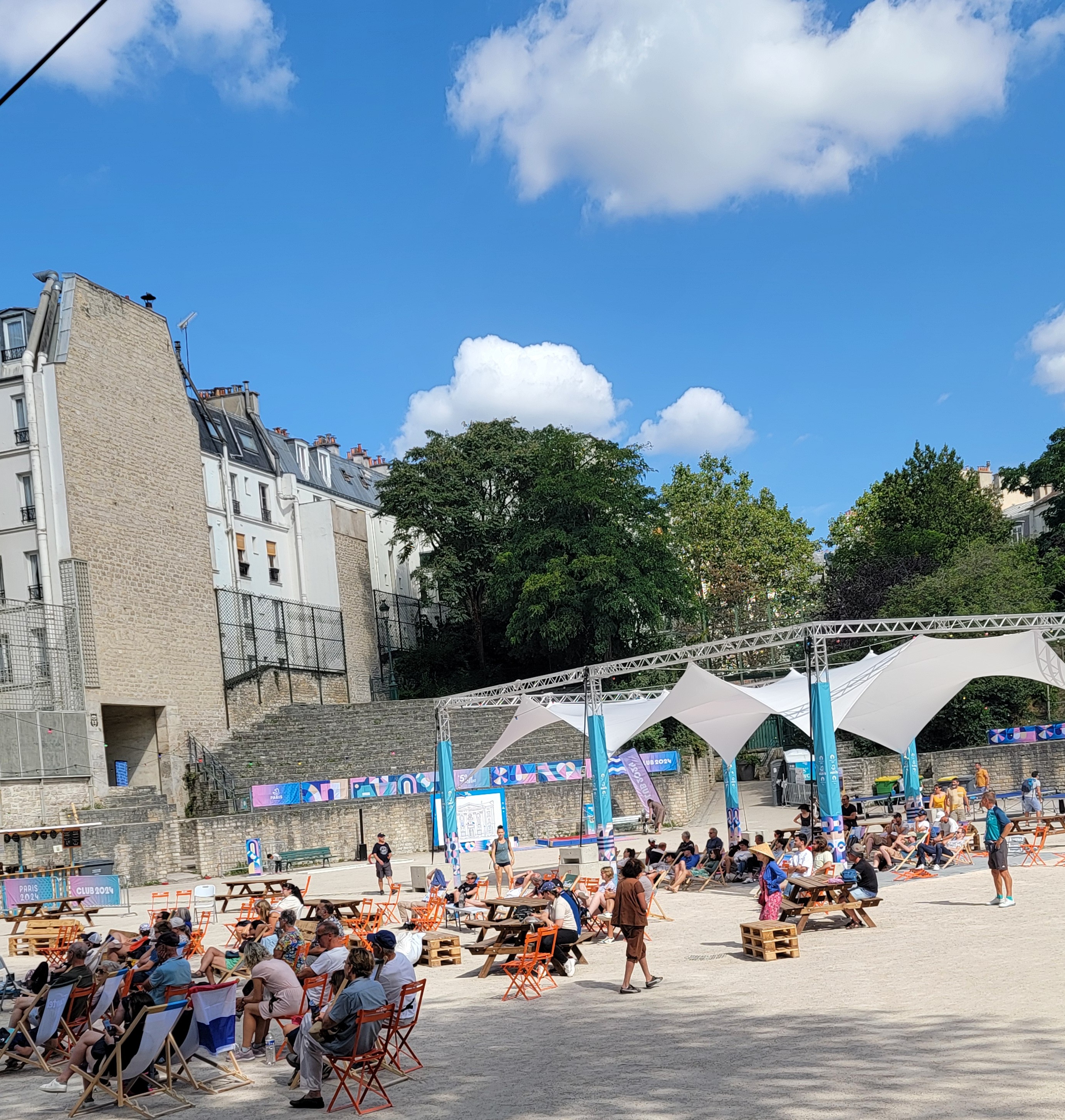
The current park was originally the sub-sub-basement of the amphitheatre. The surrounding walls are over 2,000 years old. While the Parisi tribe lived on the Isle de la Cite, the Romans dominated the rest of the area. This, however, was way out in the countryside. The Romans lived in this area for a couple of centuries, but after they were gone and time marched on, the amphitheatre fell into disarray. The stones were taken for other buildings, and the area became a trash pit. A lot of The Wall trash/stones/etc. was placed here because it was convenient, and once it was all filled in, everyone thought that the area was just a big hill!
In the 19th century the area was developed. As they were digging foundations, they found the remains of these walls. As they excavated, Victor Hugo (so say my notes?) was one of the leading voices stating that the area had to be preserved for people to come and use it. The built-in seating still remains after being excavated, and there are now South-facing vineyards (so the wine is drinkable, versus the Montmartre wine grapes, which are North-facing and bitter!).
The Bievre flows underneath, which allowed the Romans to flood the arena for water jousting, as mentioned above. It was basically a bunch of guys rowing, and a guy in front “with a stick” (per Hannah). She said that the ad for the new Gladiator movie actually shows this in action!
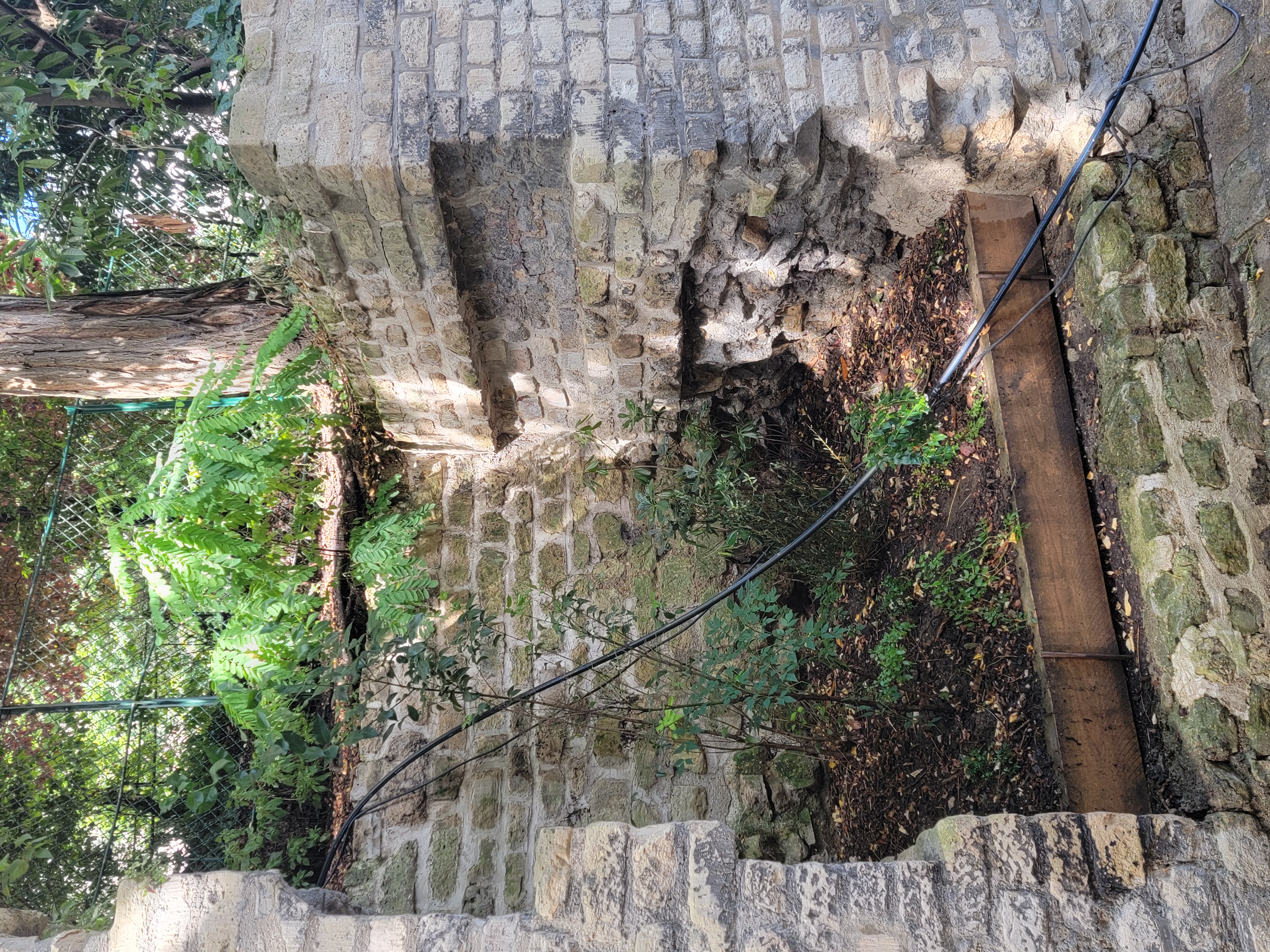
The alcoves, one of which you can see above, were actually the cut-outs in the sub basement wall that held the huge wooden pillars supporting the arena above.




Here are some random street shots. :-) Although I did not take a photo of it, we passed a mosque that has an amazing tea room and pastries, and Hannah said it was well worth a visit (we didn’t have time.).
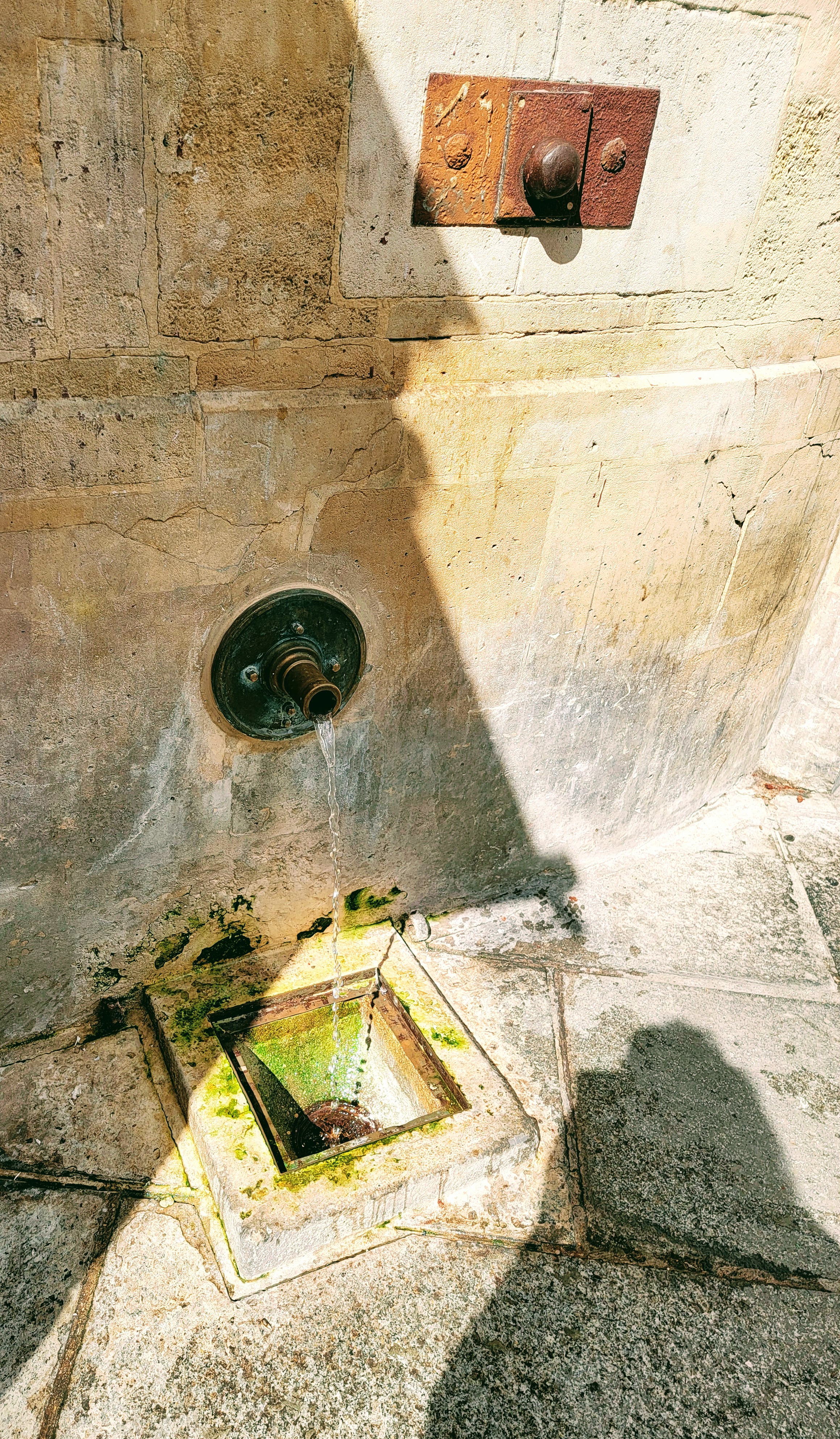

This is a standpipe. Fresh drinking water has been running from it since 1636. There are still a few of these around Paris. But don’t forget the Wallace Fountains (we talked about these on the Maris tour), where Wallace, a British engineer, came to Paris and realized that the standpipes were few and far between, so people were drinking wine instead – basically staying drunk and dehydrated. (The photo above shows a worker retrofitting this Wallace fountain with the misters.)

Look what we found! Odette – the store our wonderful treats from the hotel came from!!
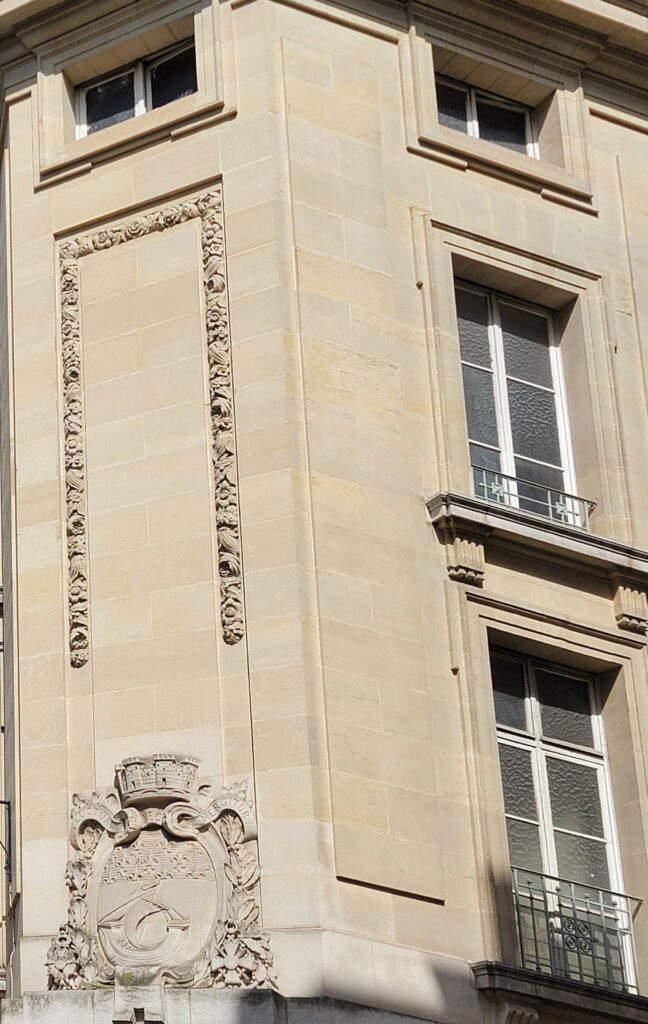

Remember the “boat logo” of Paris that we learned about at Montmartre? Here it is again! :-)
Lots more notes about history….
The inhabitants used to throw sewer waste out of the window before indoor plumbing. The king made folks yell “Gardez l’eau!” (“Watch out for water”) 3 seconds before doing it, so that you could “seek shelter.” “L’eau” was bastardized into “Loo” by the English…
George Orwell lived here…
la la la….
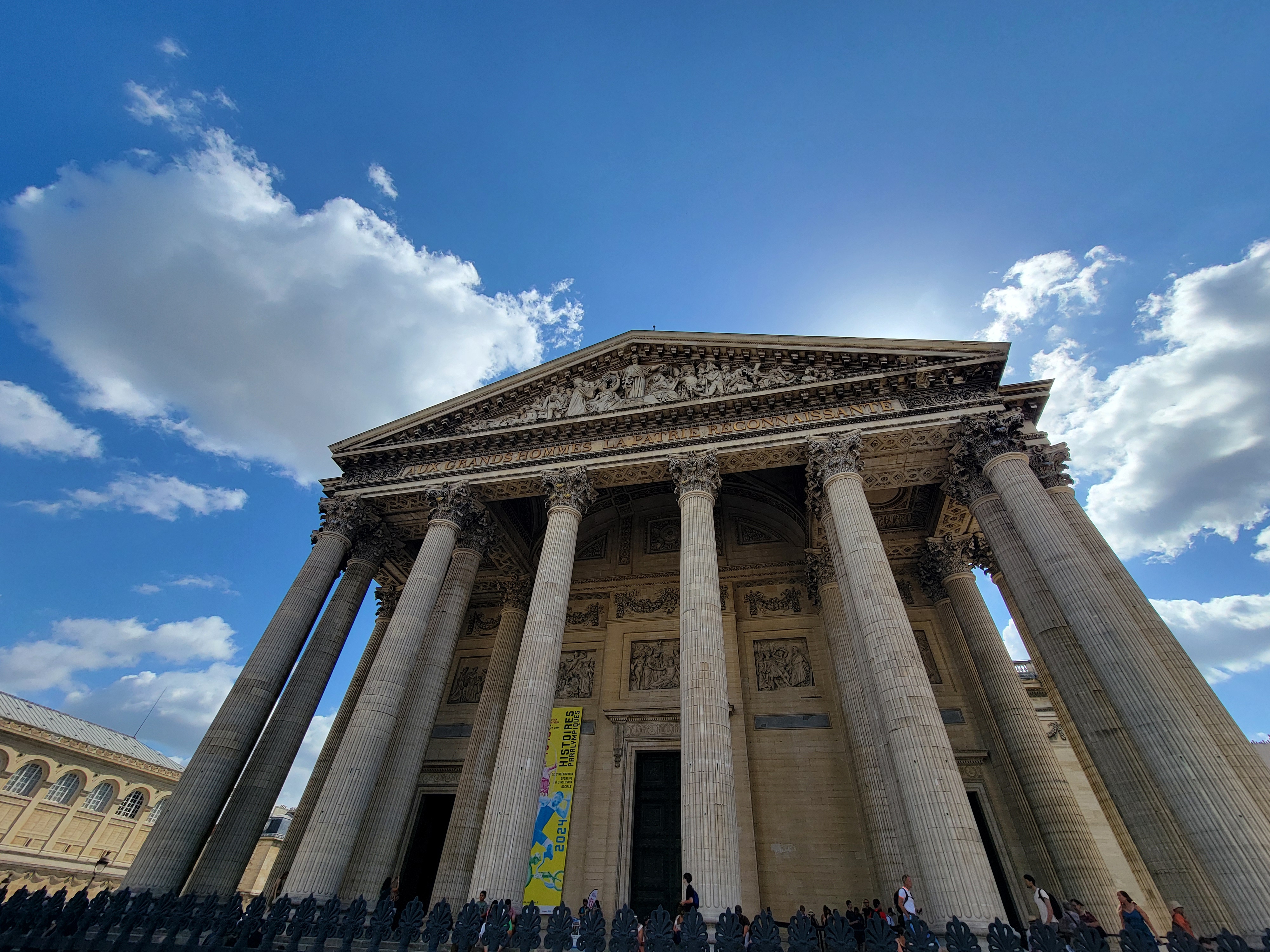




The Pantheon: Not to be missed. (Okay, I missed it because I was exhausted, but Leann and the Aments went!) It has been a building of importance since Roman times. Originally it was a forum, then in 1744 it was supposed to be a church dedicated to St. Genevieve and the construction was paid for (and she is interred there), but the 1789 French Revolution made France “secular” so it was only a church for a short while. (It has a cross on top from that era.)
After the Revolution it was deemed a “secular temple,” and after 1796, “great men” (75 of them) and women (6) were buried here who had “glorified the French homeland” and were important for that reason. In other words, you were buried here not because of your personal fame, but because of the contribution that you made to the Nation. (More than half of all the “pantheonisations” were made under Napoleon’s rule during the First Empire.)
While the usual method was to exhume someone and then re-bury them in the mausoleum here, Victor Hugo was one of the few people interred here immediately at his death. Others exhumed and re-buried here are Voltaire, Braille, Alexandre Dumas, Emile Zola, Soufflot (its architect), Jean Jacques Rousseau, and Marie Curie. Curie was the first woman interred. She was interred in 1995 with her husband, because she wasn’t “worthy” on her own – though she of course had 2 Nobel Prizes to her husband’s one. Their tombs are lead-lined, because their bodies are still radioactive. Two heroines of the French Resistance, Genevieve de Gaulle-Anthonioz and Germaine Tillion, were interred here in 2015.
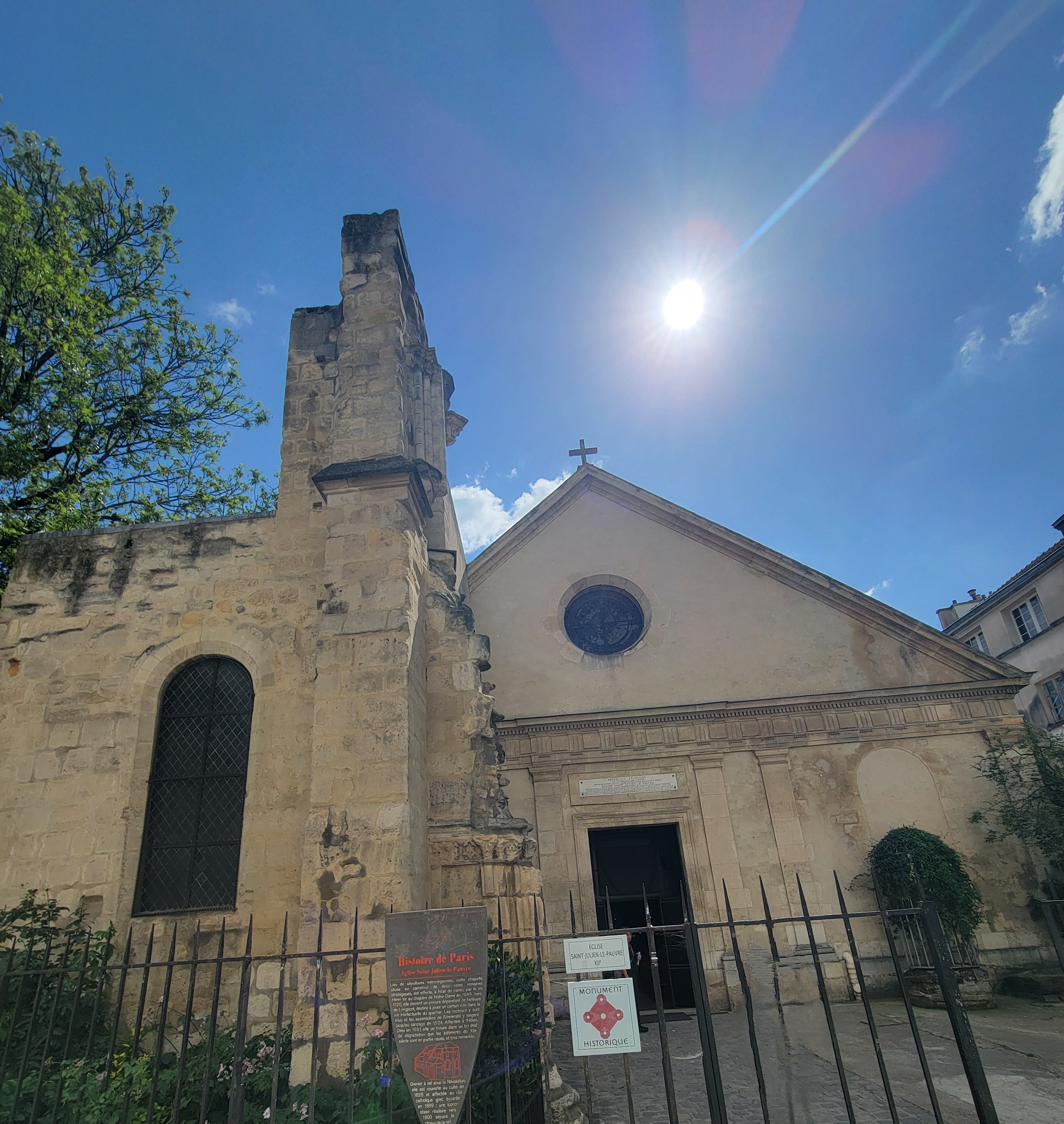
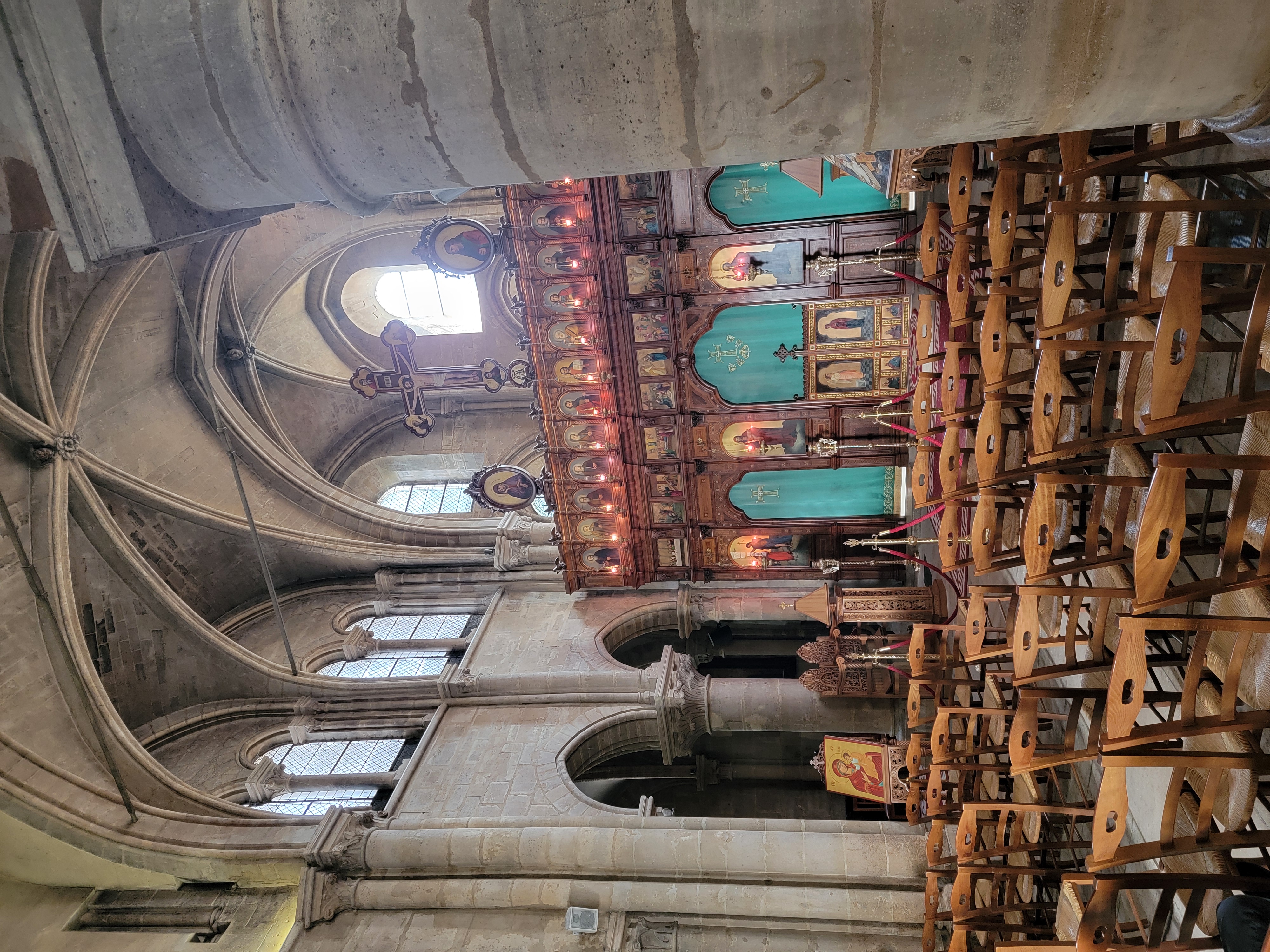
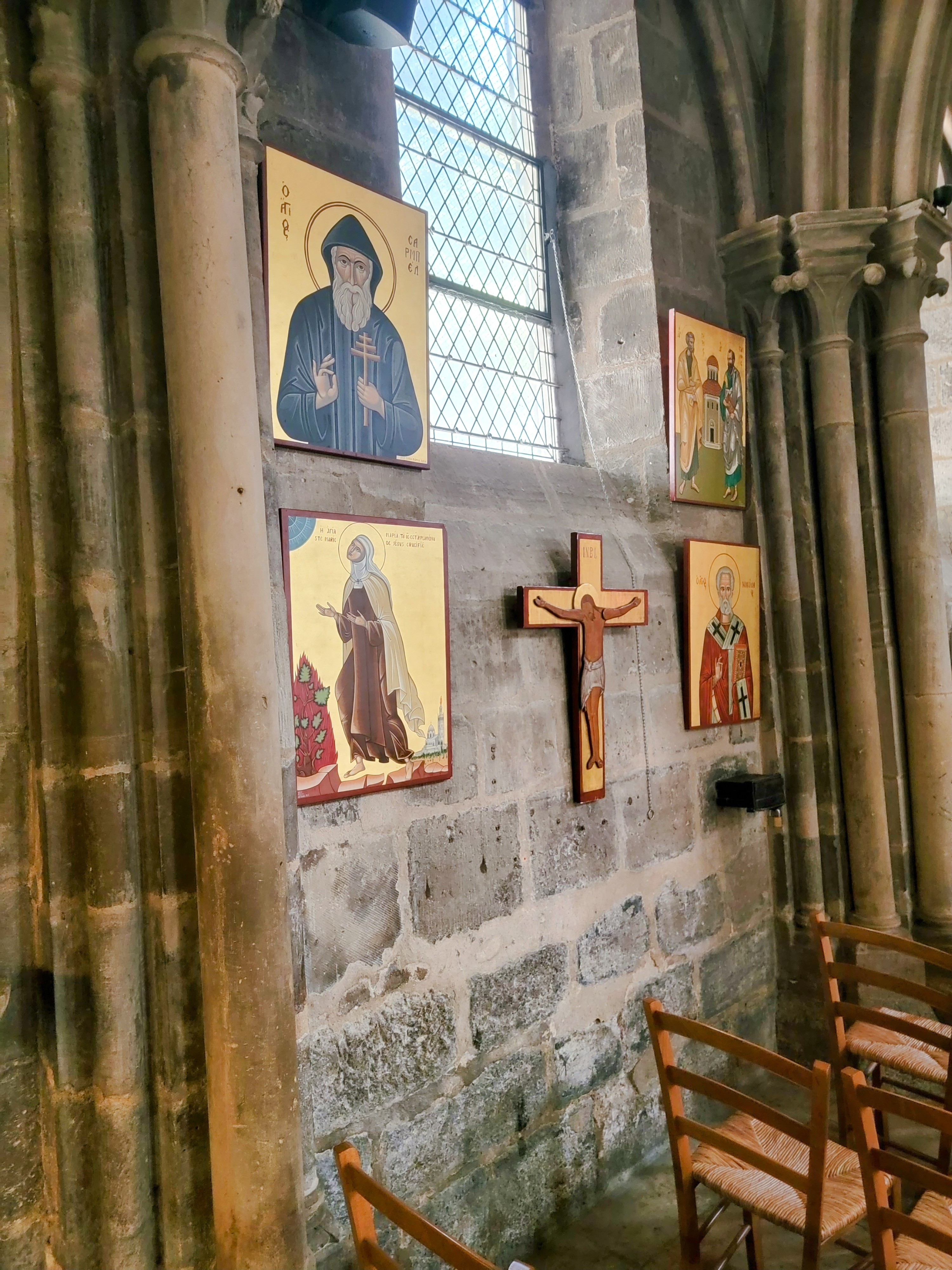
Above: Eglise St. Julien Le Pauvre is the second oldest church in Paris (it’s older than Notre Dame). It is now an Orthodox church.
Speaking of Notre Dame, the top of the previous spire was a cockerel that had religious relics in it.
After the spire went crashing into the church during the fire, they figured that all was lost – but the cockerel was retrieved, and still had the relics in it.
The spire has been re-built, but atop it is now a phoenix to hold the relics.
The huge bell that all the Olympians who win gold are ringing is going to be installed in Notre Dame, so that Notre Dame can still be “part of” the Olympics like other iconic Parisian landmarks have been. It is inscribed with “Olympic Games of 2024” and will join the other two huge bells once they are re-installed in the belfry.
We walked past Shakespeare and Co., a 70 year old bookstore that’s pretty iconic. Writers (to this day) can live in bunks there, as long as they agree to work in the store, read a book a day, and write an autobiography. They’re called “tumbleweeds.”




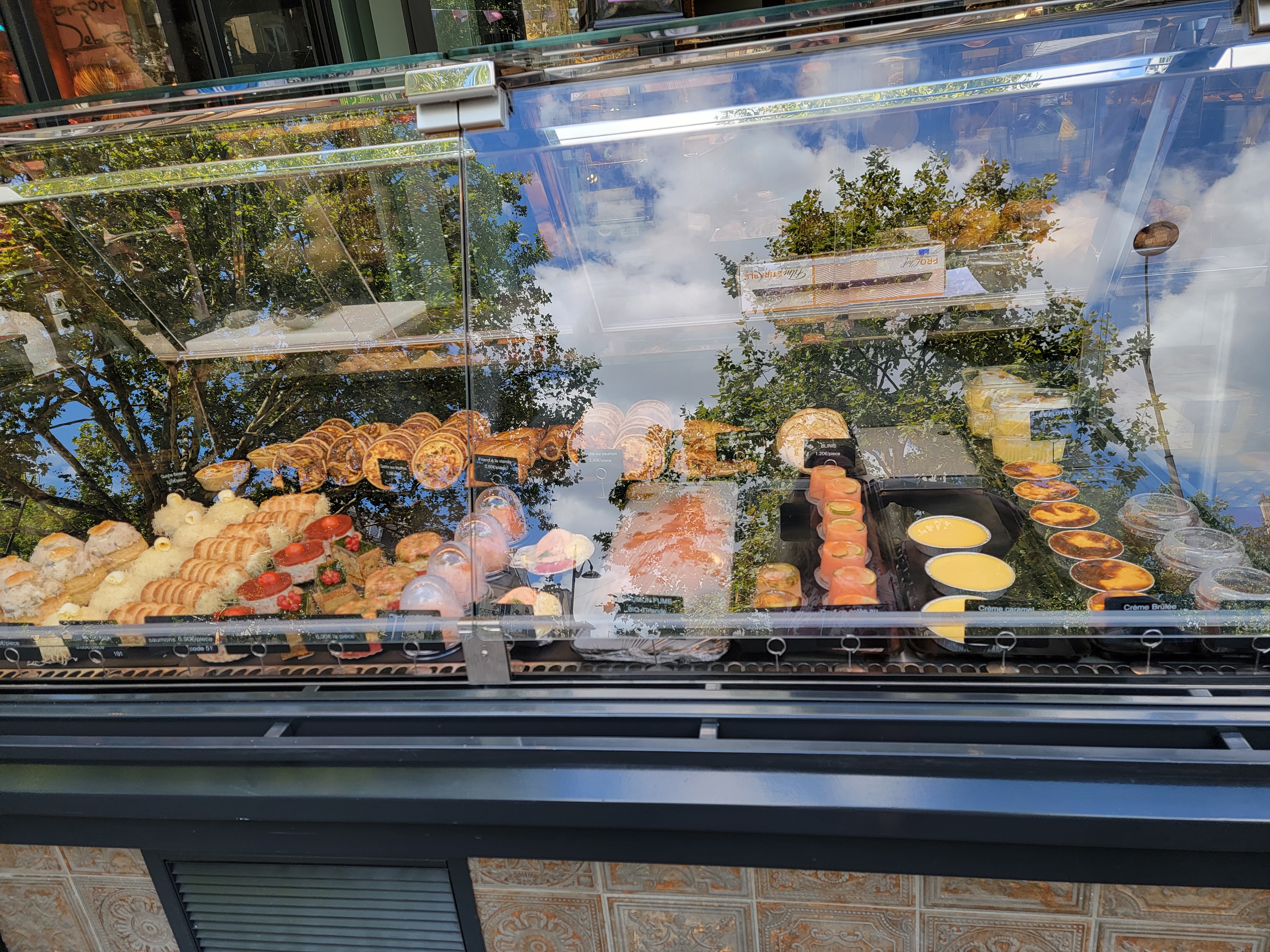
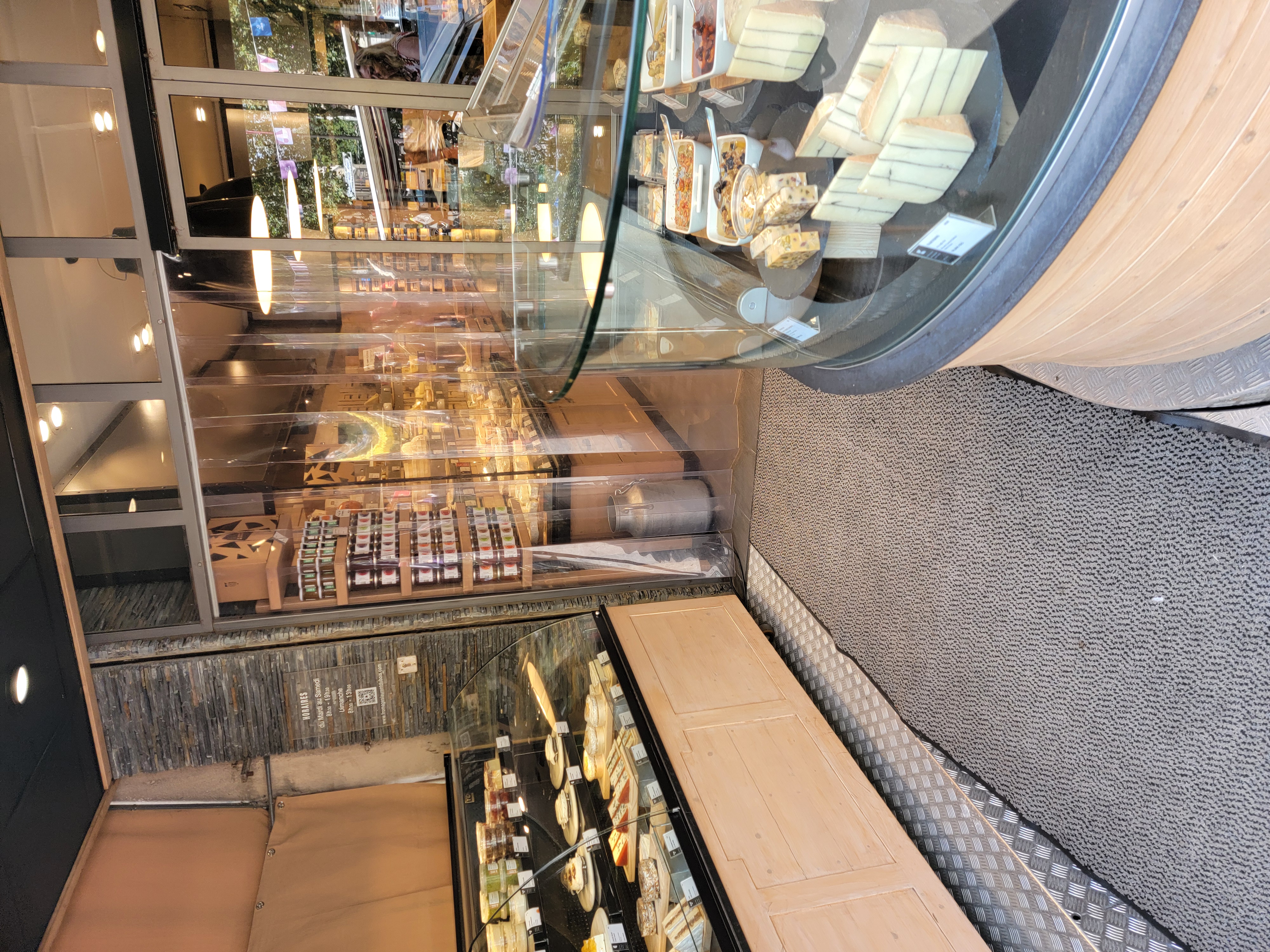
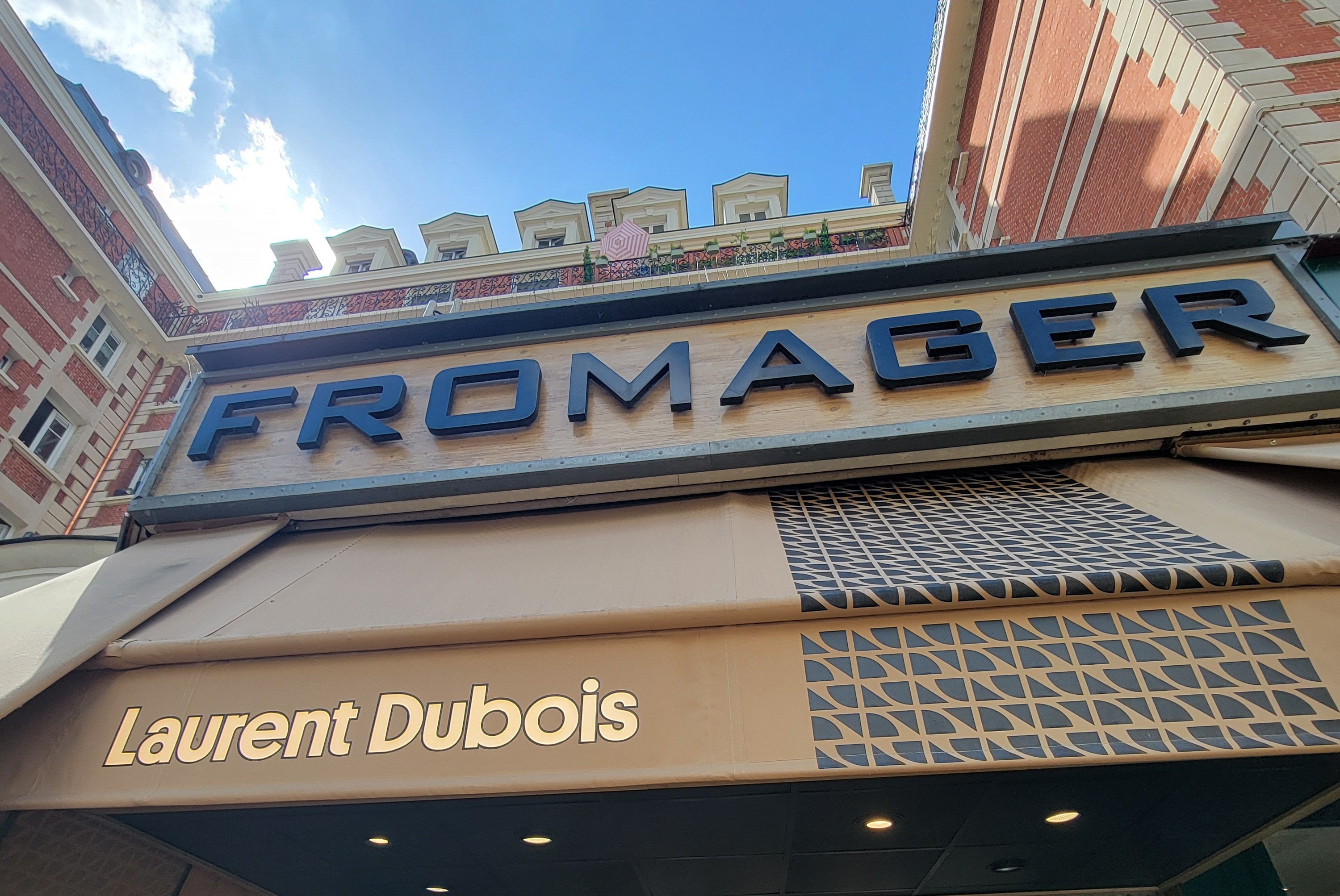

Our tour ended at a park that used to be famous for the intellectuals espousing their theories, drinking wine and coffee at the cafes…then, it was infamous, as where the intellectuals were taken to be killed a few decades later by the Nazis.
Now, it is a “flea market.”
As pictured above, there are many wonderful food shops along the side (one has won many trophies for the Best Croissant in Paris, another Best Charcuterie for head cheese. Yuck – but a Herbert favorite!!). In the photo above, you can’t tell how HUGE the loaves of bread are. Quite easily as long as my forearm. (And it is not a short forearm!)
Leann and I couldn’t decide which Mali necklace Mom would like best – so I bought them both from this lovely woman. She threw in a “lucky bracelet” for “ma mere.”
We had lunch with the Aments – which included an unfortunate choice by the guys of what turned out to be Tripe – and the Mother-in-Law of all Croque Monsieurs for Leann, pictured to the left!
As I noted above, I went back to the hotel, and Leann when to the Pantheon with the Aments. Though the view from the Dome is supposed to be spectacular, everyone was a bit weary of the “stair traipsing”!
The Pantheon is located on the mountain of Paris’ patron saint, St. Genevieve (as mentioned before), which is why the panorama is considered to be so gorgeous. It contains the Eiffel Tower, the Louvre, the Seine, etc. Though the view from Sacre Coeur is also fantastic, everything is SO far away. From the Pantheon, you are looking right down on it.
The Pantheon was built by the architect Soufflot at the behest of King Louis XV. The crypt is considered a “must see,” and most of these photos are from it. The other well known attraction is a copy of the pendulum of Foucault. In 1851, he conducted a demonstration of diurnal motion at the Pantheon by suspending a pendulum from the ceiling.



















Could this actually be “it”!? I think so! Lots of thanks to those of you who have read this blog. I love doing it, and especially love going back and seeing “Where I have been.” Next blog post? Next year, in Africa! Cheers!!

